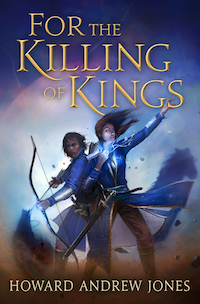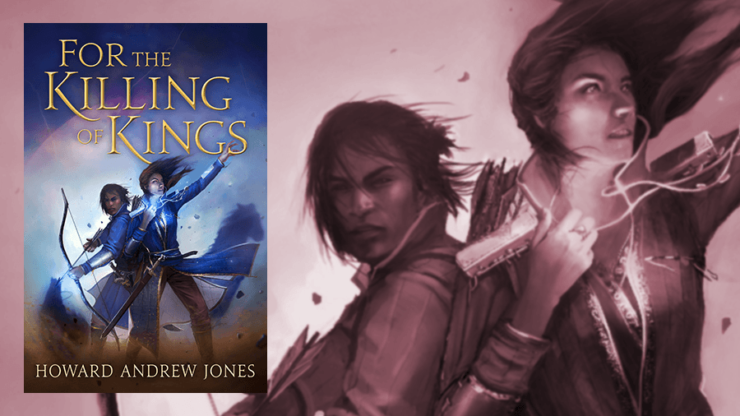When a novel’s back cover invokes one of my touchstone books as being part of its DNA, that gets my attention, but it can be a lot to live up to. And when the novel is supposedly a cross between that touchstone book and to a beloved classic of literature, that is even more for a book to live up to. It draws my attention as a reader, but my critical eye is heightened as well.
The touchstone in this particular instance is Roger Zelazny’s Chronicles of Amber, the classic in question is Alexandre Dumas’ The Three Musketeers, and the book that combines the two is historical fantasist Howard Andrew Jones’ turn into epic fantasy, For the Killing of Kings.
The novel’s set up and initial premise falls squarely into The Three Musketeers, yes, but I was even more reminded of the late Dave Duncan’s King’s Blades novels, albeit with a better gender balance amongst the cast. The novel starts us off with a mentor/student pairing, Asrahn, and his protege, the squire Elenai, a would-be member of the Musketeer like force called the Altenerai. What starts off as a simple effort to clean the hallowed blade of the now-dead hero of the kingdom turns south quickly when the sword is revealed to be a replica, not a real one. Who cares if a fake blade is in a case gathering dust? Well, the greatest enemy of the kingdom of Darassus has been kept at bay only by a prophecy that the real Irion is the sword that can kill him. And once the deception is revealed, forces start moving to suppress the knowledge. Asrahn, hero of the realm, is killed to maintain the secret.
And, in short order, the stakes become violent: if there are forces willing to kill Asrahn to keep the secret, what else are they hiding? And what would the Naor barbarians do if the legendary sword IS gone? And so the plot gets off and running. The novel follows Elenai and the taciturn Kyrkenall, another of the older generation who comes looking for Asrahn. Together the pair look for the real blade, and the truth as to what happened at the end of the last war—and just possibly stop the next one. And at the same time, Elenai learns that she has plenty of more training to undergo, particularly in magic.
This plotline is soon twinned by the story of Rylin, another student of the blade, who independently discovers the same deception, and takes a different path to searching out the truth. This earns him troubles and pursuers of his own in short order. His story does not quite shine with the brightness and interest that Elenai’s has, but he does make an interesting contrast to Elenai, and his story does show the width and the depth of the problem. (Oddly, he isn’t mentioned or hinted at in the publicity matter at all, so the first switch of the POV came to me a real surprise.)
The Amberian aspects of Jones’ novel come to the fore in the geography and worldbuilding, although I was equally reminded of the faerie land quality of Brust’s Dragaera, and even more so, the Kingdoms of Elizabeth Willey’s The Well Favored Man. The typical medieval fantasy kingdom of Darassus and its environs has a few additional aspects to it: particularly, the verse that Jones creates in and around Darasssus has the wrinkle of the “shift lands” interpolating and bounding Darassus and its neighbors. In the shifting lands, reality becomes malleable, and a storm can change reality around the travelers at a moment’s notice. Only someone trying to escape dire pursuit or seeking someone or something lost in such lands would be crazy enough to pass through the Shifting Lands. Given the plot of the novel, this turns out to be an excellent idea. The characters’ passage into this changeable landscape does evoke the idea of shadowshifting or hellriding in the Amber Chronicles rather well. I also thought of Philippa Ballantine’s Shifted Worlds novels as well. Jones fits very well and lives up to this tradition in description and use of the concept.
Buy the Book


For the Killing of Kings
The Amber chronicles are all about the fractious and colorful, literally larger than life Amber royal family—does Jones’ novel stand up on that score? The younger characters, our point of view characters to identify with, Elenai and Rylin are distinctly different: Elenai focuses on magic and her burgeoning powers, while Rylin is cast in a more martial and heroic mode. To use the Amber metaphor, they are the Merlin, Julia, and Luke set in the second Amber chronicles. We don’t really see enough of Ashrahn to get a sense of his personality, he really is more of a plot device to drive the narrative. Kyrkenall, taciturn and with a reputation as a loner drawn into the situation against his will, has some of the brooding Corwin in him. Personally, thinking of The Three Musketeers, connected him more to the brooding Athos. It is the reputation and nature of N’lahr that for me parallels the Amber chronicles most closely, and particularly the character of Amber’s greatest general and warrior, Benedict. There is definitely also a note of the Arthurian to him as well, given his sword, and other things about him that emerge in the narrative.
The novel’s real heart and center is the action beats and strong sense of pacing. The novel sometimes wants to hurry a bit too much to get to the next good bit, but it’s in service of getting Elenai and Rylin into the crucible of conflict, fire-forging them as they face various obstacles and setbacks. I have found a tendency in Amber-like novels to have the elder characters be over-powered and capable of everything, with the less experienced or younger characters pushed to the sidelines as observers or shadows of the major players. Happily, For the Killing of Kings manages to avoid this pitfall. Elenai’s skills are useful and important from the get go, as are Rylin’s. They might not have the greater experience of the full Altenerai, and have much to learn on the job, but they prove to be crucial players quickly. The characters not only grow into the roles in terms of competence, but as well as respect given by their elders and to others in their presence. One key passage has Elenai introduced to an potential adversary with all the seriousness and honor of her being an equal to her far more well known companion, complete with a on-the-spot and yet excellently appropriate heroic sobriquet. Rylin, too, finds a not small measure of prestige and honor in his own story.
The novel doesn’t end on a good off-ramp—it’s clearly meant to be the first of a series, unapologetically, with its story only begun. But the entertainment value, and the hints of even greater revelations about the past of the iconic characters, and the world, make me very interested in how Jones continues the story.
For the Killing of Kings is available from St Martin’s Press.
Read an excerpt here.
An ex-pat New Yorker living in Minnesota, Paul Weimer has been reading sci-fi and fantasy for over 30 years. An avid and enthusiastic amateur photographer, blogger and podcaster, Paul primarily contributes to the Skiffy and Fanty Show as blogger and podcaster, and the SFF Audio podcast. If you’ve spent any time reading about SFF online, you’ve probably read one of his blog comments or tweets (he’s @PrinceJvstin).










